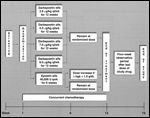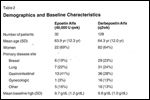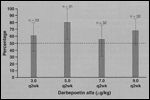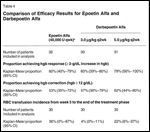Darbepoetin Alfa Administered Every 2 Weeks Alleviates Anemia in Cancer Patients Receiving Chemotherapy
The objectives of this study were to assess the safety and efficacy of darbepoetin alfa (Aranesp) administered every 2 weeks in anemic patients with solid tumors receiving chemotherapy. This was an open-label, randomized,
ABSTRACT: The objectives of this study were to assess the safety and efficacy of darbepoetin alfa (Aranesp) administered every 2 weeks in anemic patients with solid tumors receiving chemotherapy. This was an open-label, randomized, active-controlled, multicenter dose-finding study evaluating a range of every-2-week darbepoetin alfa doses. The active control arm received epoetin alfa (Epogen, Procrit) at 40,000 U weekly with a dose increase to 60,000 U weekly for subjects with an inadequate response. The lowest clinically effective doses of darbepoetin alfa in this study were 3.0 and 5.0 µg/kg every 2 weeks, with no additional benefit observed at higher doses. The percentage of patients who achieved a hematopoietic response in the 3.0- and 5.0-µg/kg groups was 66% (95% confidence interval [CI] = 46%-86%) and 84% (95% CI = 67%-100%), respectively, compared with 63% (95% CI = 46%-81%) in the epoetin alfa group. Darbepoetin alfa administered at a dose of 3.0 µg/kg every 2 weeks is safe and effective for treating anemia in patients with solid tumors on chemotherapy, and is comparable to epoetin alfa. A dose increase to 5.0 µg/kg of darbepoetin alfa administered every 2 weeks may be appropriate in patients with an inadequate initial response.
Introduction
Anemia is a significant complication of cancer and of the myelosuppressive chemotherapy used to treat cancer patients. The etiology of cancer-associated anemia is multifactorial. Contributing factors to cancer-associated anemia include decreased endogenous erythropoietin levels, erythropoietin resistance, and decreased red blood cell survival.[1] Anemia is associated with many symptoms, including weakness, dyspnea, lethargy, and fatigue. Cancer patients most often report fatigue as the symptom of their disease that has the most negative impact on their lives.[2] Studies have shown that anemia contributes to the fatigue and subsequent poor quality of life in patients with cancer.[3-5]
Iron replacement is helpful in selected cases; in most patients, symptomatic anemia is managed with red blood cell transfusions and/or with erythropoietic agents (epoetin alfa [Epogen, Procrit] or the recently approved darbepoetin alfa [Aranesp]). Studies have shown that treatment with epoetin alfa is associated with an increase in hemoglobin, a decreased incidence of blood transfusions, and an improvement in quality of life.[5-8] However, response to treatment is defined differently in these studies and the statistical methodology applied also differs, making it difficult to compare results or apply a standard criterion for response.
Limitations of treatment with epoetin alfa include ambiguity about the optimal dose and schedule due to lack of published systematic dose-finding studies, and a lack of pharmacokinetic data in the cancer setting. In addition, the necessity of weekly or more frequent office visits and the number of required injections make this therapy impractical for some. Office visits for injections add to patient discomfort, and consume valuable time and resources for patients, caregivers, and health-care professionals.[9]
Darbepoetin alfa is a unique erythropoiesis-stimulating protein that is the result of research on the structure/function relationship of erythropoietin. Although darbepoetin alfa stimulates erythropoiesis in the same manner as epoetin alfa, it is a glycoprotein that is biochemically distinct from epoetin alfa. Darbepoetin alfa contains two more N-glycosylation sites, permitting eight additional sialic acid residues relative to epoetin alfa. Increased sialic acid content correlates with a threefold increase in terminal half-life of the molecule with a consequential increase of in vivo potency.[10] This prolonged half-life allows darbepoetin alfa to be administered less frequently while maintaining comparable efficacy to the more frequently administered epoetin alfa. The prolonged half-life has been confirmed in patients with chronic renal failure and in cancer patients undergoing multiple cycles of chemotherapy.[11,12] Darbepoetin alfa has been shown to be effective in treating chemotherapy-induced anemia when administered as infrequently as once every 3 or 4 weeks.[13] These findings have important implications for the quality of life of patients with cancer, as well as potential implications for overall resource utilization.
This dose- and schedule-finding study of darbepoetin alfa was conducted in two parts in subjects with solid tumors receiving cyclic chemotherapy.[14] The first part of this study (part A) evaluated a range of weekly doses of darbepoetin alfa with an epoetin alfa active control group administered as indicated in the product label (150 U/kg three times per week with a possible dose increase). The second part of this study (part B) evaluated a range of every-2-week doses of darbepoetin alfa with an epoetin alfa active control group administered at 40,000 U weekly with a possible dose increase.
TABLE 1

Mean Change in Hemoglobin and Incidence of Transfusions for Weekly Darbepoetin Alfa Doses
As reported by Glaspy et al,[14] in part A of this study, characterization of the relationship between darbepoetin alfa dose and effect showed increasing effect with higher doses in the dose range of 0.5 to 4.5 µg/kg weekly. The percentage of patients achieving a hemoglobin response (³ 2.0 g/dL increase in hemoglobin from baseline) ranged from 23% (95% confidence interval [CI] = 0%-46%) for the 0.5-µg/kg group to 76% (95% CI = 59%-94%) for the 4.5-µg/kg group over the 12-week treatment period. The mean change in hemoglobin and the incidence of transfusions were similar for the 1.5-µg/kg darbepoetin alfa dose group and the epoetin alfa group, with additional benefit observed at higher doses (Table 1). Subjects receiving higher doses of darbepoetin alfa appeared to have a faster time to hemoglobin response, such that the 4.5-µg/kg dose group had a median time to response of 7 weeks compared with 10 weeks for lower doses and epoetin alfa. Doses in excess of 4.5 µg/kg did not appear to confer any increase in efficacy.
In the epoetin alfa group, patients with an inadequate initial response were allowed a dose increase at week 8 to 300 U/kg according to the US package insert for Procrit. Consequently, comparisons with darbepoetin alfa after this time point are confounded. In general, however, 1.5-µg/kg darbepoetin alfa weekly appeared to have a similar effect on hemoglobin variables compared with the epoetin alfa control arm up to week 8. Doses of darbepoetin alfa administered weekly at 2.25 µg/kg and above showed evidence of enhanced efficacy relative to the active control group. The differences between the darbepoetin alfa and active control groups observed earlier in the study were maintained at 12 weeks despite the epoetin alfa dose increase at week 8.
This paper reports findings from part B of the study for the purposes of identifying an appropriate dose of darbepoetin alfa administered every 2 weeks and of providing a preliminary comparison of every-2-week doses of darbepoetin alfa to weekly epoetin alfa.
Patients and Methods
Patients
The institutional review boards of participating medical centers approved the protocol, and all patients gave written informed consent before any study-related procedures were done. Inclusion criteria for patient eligibility were as follows: 18 years of age or older, diagnosed with a solid tumor, and scheduled to receive cyclic chemotherapy for at least 12 weeks after study enrollment. Patients also were required to be anemic (hemoglobin ≤ 11.0 g/dL), to have adequate serum folate and vitamin B12 concentrations, a life expectancy of at least 6 months, an Eastern Cooperative Oncology Group performance status of 0 to 2, and adequate renal and liver function. Exclusion criteria included overt bleeding or hemolysis, receipt of more than two red blood cell transfusions within 4 weeks or any red blood cell transfusions within 16 days of randomization, receipt of epoetin alfa therapy within 8 weeks, known primary hematologic disorders that could cause anemia, and primary or metastatic disease of the central nervous system, or active cardiovascular diseases.
Study Design
FIGURE 1

Study Design-Anemic patients with solid tumors who were receiving multicycle chemotherapy.
The data presented here were obtained from a phase I/II, multicenter, randomized, active-controlled, open-label study in anemic patients with solid tumors who were receiving multicycle chemotherapy. Patients were randomized to receive 12 weeks of subcutaneous therapy with darbepoetin alfa or epoetin alfa. Patients were randomized to receive one of four doses of darbepoetin alfa (3.0, 5.0, 7.0, and 9.0 µg/kg every 2 weeks) or epoetin alfa at 40,000 U weekly (Figure 1) in an equal allocation.
In keeping with common medical practice, subjects in the epoetin alfa group could have their dose increased to 60,000 U weekly at day 35 (study week 6) if they had an inadequate initial response. Day 35 was chosen for increasing the epoetin alfa dose based on data available at the time of initiation of the study with regard to common community practice with this agent. No patients receiving darbepoetin alfa were permitted to receive a dose increase at any time during the study; therefore, a direct comparison of the efficacy of an individual dose of darbepoetin alfa with epoetin alfa may be confounded for some end points. However, descriptive comparisons can be made between the two groups.
Safety End Points
All patients who received at least one dose of study drug were included in the safety analysis. Safety was assessed by screening for antibody formation to darbepoetin alfa, and by summarizing reports of adverse events. All adverse events were grouped according to the body system affected and by preferred term within body system according to a modified World Health Organization Adverse Reaction Term (WHOART) dictionary.
Efficacy End Points
The efficacy end points evaluated included hemoglobin response (³ 2.0 g/dL increase in hemoglobin over baseline in the absence of a red blood cell transfusion in the past 28 days), hemoglobin correction (hemoglobin ³ 12 g/dL in the absence of any red blood cell transfusion in the past 28 days), and hematopoietic response (hemoglobin value > 12.0 g/dL or a ³ 2.0-g/dL increase in hemoglobin over baseline in the absence of a red blood cell transfusion in the past 28 days) as defined in previous studies with epoetin alfa,[5,6] and mean change in hemoglobin from baseline. The incidence of red blood cell transfusions from week 5 to the end of the treatment phase was also evaluated.
Statistical Analysis
Statistical analyses were conducted using the intent-to-treat analysis set (ie, all patients randomized to study drug who received at least one dose) with the last observation carried forward approach used to impute missing values. Baseline demographic and clinical characteristics were summarized by the mean (standard deviation) for continuous measures and number (percentage) for categorical measures. The proportion of patients achieving hematopoietic response was estimated by subtracting the Kaplan-Meier estimate of the survivor function at the time of the last observed hematopoietic response from 1, with 95% confidence limits calculated by using Greenwood’s estimate of the variance.
Results
Patient Demographics and Disposition
A total of 128 patients received one of the every-2-week darbepoetin alfa doses and 32 patients received epoetin alfa. Baseline demographic and clinical characteristics were similar between all groups and are summarized in Table 2. In general, baseline demography and clinical characteristics were similar between the darbepoetin alfa dose groups, although the 7.0-µg/kg group had a slightly lower baseline hemoglobin concentration, and had a lower proportion of subjects with a baseline hemoglobin above 10 g/dL (25% vs at least 44% for the other three dose groups).
TABLE 2

Demographics and Baseline Characteristics
The proportion of patients completing 3 months of study drug treatment and follow-up was similar for darbepoetin alfa and epoetin alfa. Discontinuation of study drug treatment was due primarily to death, disease progression, or changes in chemotherapy unrelated to study drug. All study groups had similar reasons for early termination of study drug.
Efficacy Results
Darbepoetin Alfa Dose-Finding
FIGURE 2

Kaplan-Meier Proportion (95% CI) of Patients Achieving a Hemoglobin Response Through the End of Treatment FIGURE 3

Kaplan-Meier Proportion (95% CI) of Subjects Achieving Hemoglobin Correction Through the End of Treatment
All groups of darbepoetin alfa achieved a hemoglobin response of ³ 50%, with the 5.0-mg/kg group achieving higher observed efficacy than the 3.0-µg/kg group for hemoglobin end points (Figure 2). For example, the Kaplan-Meier estimate for the proportion of patients achieving at least a 2-g/dL increase in hemoglobin from baseline was 60% in the 3.0-µg/kg group and 79% in the 5.0-µg/kg group. All dose cohorts of darbepoetin alfa also achieved a ³ 50% rate of hemoglobin correction over the course of the treatment phase (Figure 3), and all darbepoetin alfa doses appeared to be equally effective. Hematopoietic response rates (Kaplan-Meier proportion) were 66% (95% CI = 46%-86%), 84% (95% CI = 67%-100%), 58% (95% CI = 35%-82%), and 71% (95% CI = 53%-89%) for the 3.0-, 5.0-, 7.0-, and 9.0-µg/kg dose groups, respectively.
FIGURE 4

Mean (SE) Change in Hemoglobin From Baseline Through the End of Treatment
The mean (standard error) change in hemoglobin concentration from baseline to the end of the treatment phase was higher in the 5.0-µg/kg group than in the 3.0-µg/kg group, but no appreciable additional increase was observed at higher doses (Figure 4). Using an alternative statistical approach in which only those subjects who completed dosing were included in the analysis, the mean change in hemoglobin from baseline in the 3.0-, 5.0-, 7.0-, and 9.0-µg/kg dose groups was 0.61, 0.58, 0.61, and 1.23 g/dL at week 4, respectively, and 1.61, 2.36, 2.35, and 2.39 g/dL at week 13, respectively.
TABLE 3

Red Blood Cell Transfusion Incidence From Week 5 to the End of the Treatment Phase
The incidence of red blood cell transfusion from week 5 to the end of the treatment phase was also examined in this study; however, no consistent relationship to darbepoetin alfa dose was observed (Table 3).
Comparison of Darbepoetin Alfa to Epoetin Alfa
A consistent increase in response was observed for the 5.0-µg/kg darbepoetin alfa dose group relative to the 3.0-µg/kg group, with no additional benefit observed at higher doses. Therefore, the 3.0- and 5.0-µg/kg every-2-week doses were identified as the lowest clincally effective doses for darbepoetin alfa. Efficacy results for these doses were compared with those of the epoetin alfa active control group, which included patients who had received a dose escalation to 60,000 U weekly.
TABLE 4

Comparison of Efficacy Results for Epoetin Alfa and Darbepoeitin Alfa
As shown in Table 4, the 3.0-µg/kg darbepoetin alfa group was similar to the epoetin alfa group with respect to hemoglobin response and hemoglobin correction end points, while the 5.0-µg/kg group had higher observed rates. Similarly, the hematopoietic response rates (Kaplan-Meier proportion) of the 3.0- and 5.0-µg/kg groups were 66% (95% CI = 46%-86%) and 84% (95% CI = 67%-100%), respectively, compared with 63% (95% CI = 46%-81%) in the epoetin alfa group. With respect to red blood cell transfusions, the epoetin alfa group had an observed higher incidence of transfusions from week 5 to the end of treatment than either the 3.0- or 5.0-µg/kg groups; however, as the sample size is small, meaningful conclusions with respect to treatment differences for this end point cannot be drawn.
Safety
Fatigue, nausea, diarrhea, fever, vomiting, and injection site pain were the most frequently reported adverse events. These events are expected in a population of patients with solid tumors who are receiving chemotherapy. Adverse events occurred at a similar frequency within the weekly darbepoetin alfa, every-2-week darbepoetin alfa, and epoetin alfa groups in both parts of the study. The rates of serious adverse events and adverse events of grade 3 or greater were similar in patients receiving darbepoetin alfa and in those receiving epoetin alfa, and were generally expected and consistent with known complications of cancer and cytotoxic chemotherapy. No antibodies to darbepoetin alfa were detected, and no clinical sequelae consistent with the presence of neutralizing antibodies were observed.
Discussion
Epoetin alfa use has been shown to improve cancer-associated anemia and the patient’s subsequent quality of life, yet some significant limitations do exist.[5-7] For example, epoetin alfa has a short half-life and must be administered weekly or more often, requiring the patient to make frequent trips to the doctor and to receive multiple injections. In addition, to achieve a therapeutic effect on hemoglobin, the effective weekly epoetin alfa dose must be increased 33% above the three-times-weekly epoetin alfa dose,[15] causing an increase in cost relative to three-times-weekly administration.
The prolonged half-life of darbepoetin alfa permits less frequent administration compared with epoetin alfa. Less-frequent dosing has many benefits, including fewer office visits, fewer injections, less time missed from work for both the patient and caregiver, and less patient discomfort. In contrast to epoetin alfa, the added patient benefit of less-frequent dosing does not require an increase in the overall dose and thus does not come at an added economic cost over more frequent administration.
The limitations of this study include the relatively small sample size and its open-label design. However, because the efficacy end points of the study revolve around the objective measurements of hemoglobin, the nonblinded nature of the study was unlikely to have caused significant bias. The open-label nature of the study could, however, have caused some potential bias in adverse event reporting. In addition, the dose range studied was narrow, and as substantial differences in treatment effect between the darbepoetin alfa dose groups were not observed, questions remain as to the nature of the dose-response relationship for every-2-week darbepoetin alfa doses. However, the results reported here support the conclusion that all darbepoetin alfa doses were clinically effective, and that some increase in response was observed as the dose increased from 3.0 to 5.0 µg/kg, above which a plateau effect was noted.
Finally, as this study permitted a dose escalation in the epoetin alfa group at week 6, direct comparisons between the darbepoetin alfa and epoetin alfa groups are somewhat confounded. However, as this dose escalation is likely to bias the results in favor of epoetin alfa treatment, we conclude from the results of this study that darbepoetin alfa at a dose of 3.0 µg/kg every 2 weeks has comparable efficacy to epoetin alfa administered at 40,000 U weekly with a dose increase to 60,000 U weekly for patients with an inadequate initial response. An increase to 5.0 µg/kg every 2 weeks may be appropriate in patients with an inadequate initial response to darbepoetin alfa at 3.0 mg/kg every 2 weeks.
In summary, the results of this study suggest that darbepoetin alfa administered every 2 weeks is safe and effective for the treatment of anemia in patients with cancer. The availability of an erythropoietic agent that can be administered less frequently will provide greater flexibility in the therapeutic options available to patients and their health-care providers.
Acknowledgment:Kathleen Raftery, MD, assisted in writing the manuscript.
References:
1. Miller CB, Jones RJ, Piantadosi S, et al: Decreased erythropoietinresponse in patients with anemia of cancer. N Engl J Med 322:1689-1692, 1990.
2. Curt GA: Impact of fatigue on quality of life in oncology patients. SeminHematol 37(4 suppl 6):14-17, 2000.
3. Vogelzang NJ, Mani S, Schilsky RL, et al: Phase II and pharmacodynamicstudies of pyrazine diazohydroxide (NSC 361456) in patients with advanced renaland colorectal cancer. Clin Cancer Res 4(4):929-934, 1998.
4. Cella D: Factors influencing quality of life in cancer patients: Anemiaand fatigue. Semin Oncol 25(3 suppl 7):43-46, 1998.
5. Gabrilove JL, Cleeland C, Livingston RB, et al: Clinical evaluation ofonce-weekly dosing of epoetin alfa in chemotherapy patients: Improvements inhemoglobin and quality of life are similar to three-times-weekly dosing.
J Clin Oncol 19:2875-2882, 2001.
6. Demetri GD, Kris M, Wade J, et al: Quality-of-life benefit in chemotherapypatients treated with epoetin alfa is independent of disease response or tumortype: Results from a prospective community oncology study. J Clin Oncol16:3412-3425, 1998.
7. Glaspy J, Bukowski R, Steinberg D, et al: Impact of therapy with epoetinalfa on clinical outcomes in patients with nonmyeloid malignancies during cancerchemotherapy in community oncology practice. J Clin Oncol 15:1218-1234, 1997.
8. Littlewood TJ, Bajetta E, Nortier J, et al: Effects of epoetin alfa onhematologic parameters and quality of life in cancer patients receivingnonplatinum chemotherapy: Results of a randomized, double-blindplacebo-controlled trial. J Clin Oncol 19:2865-2874, 2001.
9. Ansari RH, Glaspy JA, Lu J, et al: Assessing medication related disruptionof life: results from a survey of patients receiving prophylactic filgrastim toprevent chemotherapy-induced neutropenia (CIN). Proc Am Soc Clin Oncol 21:201b,2002.
10. Egrie JC, Dwyer E, Lykos M, et al: Novel erythropoiesis stimulatingprotein (NESP) has longer serum half-life and greater in vivo biologicalactivity than recombinant human erythropoietin (rHuEPO). Blood 90:56a-57a, 1997.
11. Macdougall IC, Gray SJ, Elston O, et al: Pharmacokinetics of novelerythropoiesis stimulating protein compared with epoetin alfa in dialysispatients. J Am Soc Nephrol 10:2392-2395, 1999.
12. Glaspy J, Colowick AB, Heatherington A, et al: Novel erythropoiesisstimulating protein (NESP) exhibits a prolonged serum half life (t1/2) inoncology patients (pts). Proc Am Soc Clin Oncol 19:54a, 2000.
13. Kotasek D, the Darbepoetin Alfa 980291 Study Group, Berg R, et al:Randomized, double-blind, placebo-controlled, phase I/II dose-finding study ofNESP administered once every three weeks in solid tumor patients. Blood 96:294a,2000.
14. Glaspy JA, Jadeja J, Justice G, et al: Darbepoetin alfa given every 1 or2 weeks alleviates anemia associated with cancer chemotherapy. Br J Cancer87:268-276, 2002.
15. Cheung W, Minton N, Gunawardena K: Pharmacokinetics and pharmacodynamicsof epoetin alfa once weekly and three times weekly. Eur J Clin Pharmacol57(5):411-418, 2001.
Oncology Peer Review On-The-Go: Cancer-Related Fatigue Outcome Measures in Integrative Oncology
September 20th 2022Authors Dori Beeler, PhD; Shelley Wang, MD, MPH; and Viraj A. Master, MD, PhD, spoke with CancerNetwork® about a review article on cancer-related fatigue published in the journal ONCOLOGY®.